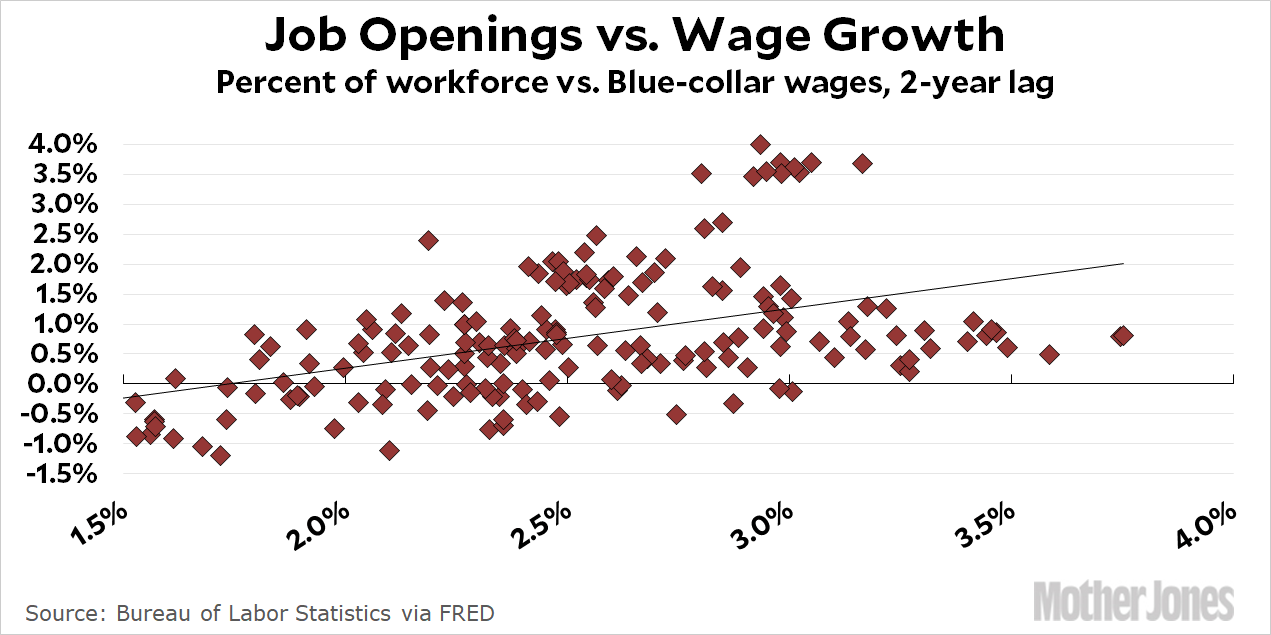For the first time in recent memory, I’m actually having trouble finding stuff to blog about this morning. Is it the calm before the storm?
So let’s go back to a subject I wandered into a few days ago: if unemployment is so low, why isn’t there more pressure for wages to rise? The answer, presumably, is that the unemployment rate is no longer a very good indicator of whether the labor market is tight. So what is?
I was noodling about this yesterday, trying to come up with something that, by definition, indicates a tight labor market. I had a hard time coming up with anything, but eventually settled on job openings. If the number of job openings is, say, 2 percent of the workforce, then there aren’t many jobs to be had. The labor market is loose. If it’s 5 percent, there are lots of jobs out there and it should be a seller’s market. The job market is tight.
Now, I realize I’m wading around in the kiddie pool on a subject that other people have probably thought about far more deeply, but that’s never stopped me before. So I plotted job openings vs. wage growth to see if there was any correlation. There wasn’t. Not even slightly. I tried it with both nominal and real wage growth, and the regression line was dead flat in both cases.
That was odd. Even if the number of job openings isn’t a perfect indicator of labor market tightness, it should indicate something. You’d think there would be at least a mild correlation. So then I tried it with a lag of one year. And one-and-a-half years. And two years. And two-and-a-half years. The best correlation I got was using real wage growth and a 2-year lag:

That’s not the worst correlation in the world, but it’s not great either. To the extent that it means anything, it means that it takes two full years of labor tightness before companies begin to raise wages to attract workers.
That’s actually a plausible hypothesis, but my difficulties with this ended up leading me in an entirely different direction: Is wage growth simply not linked very tightly to the labor market anymore? We see anecdotal evidence of this frequently in news stories that feature CEOs moaning about how hard it is to attract qualified workers—but not raising wages to attract the workers they need. For one reason or another, perhaps companies these days simply don’t react to labor shortages by raising wages.
I have no idea if this is true. I’m posting this primarily because (a) it’s kind of interesting and (b) maybe it will spark an interesting conversation.
POSTSCRIPT: I should note that my interest is usually with blue-collar workers, not computer programmers and attorneys. For that reason, I look at the wages of production and nonsupervisory workers, who make up 70 percent of the workforce. Ideally, then, I’d look at blue-collar job openings vs. blue-collar wages, but I don’t have the data for that. So I’m comparing all job opening to blue-collar wages. It’s quite possible, of course, that a tight labor market in general doesn’t necessarily mean a tight labor market in semi-skilled jobs. It’s just one more thing that might be messing this up.













